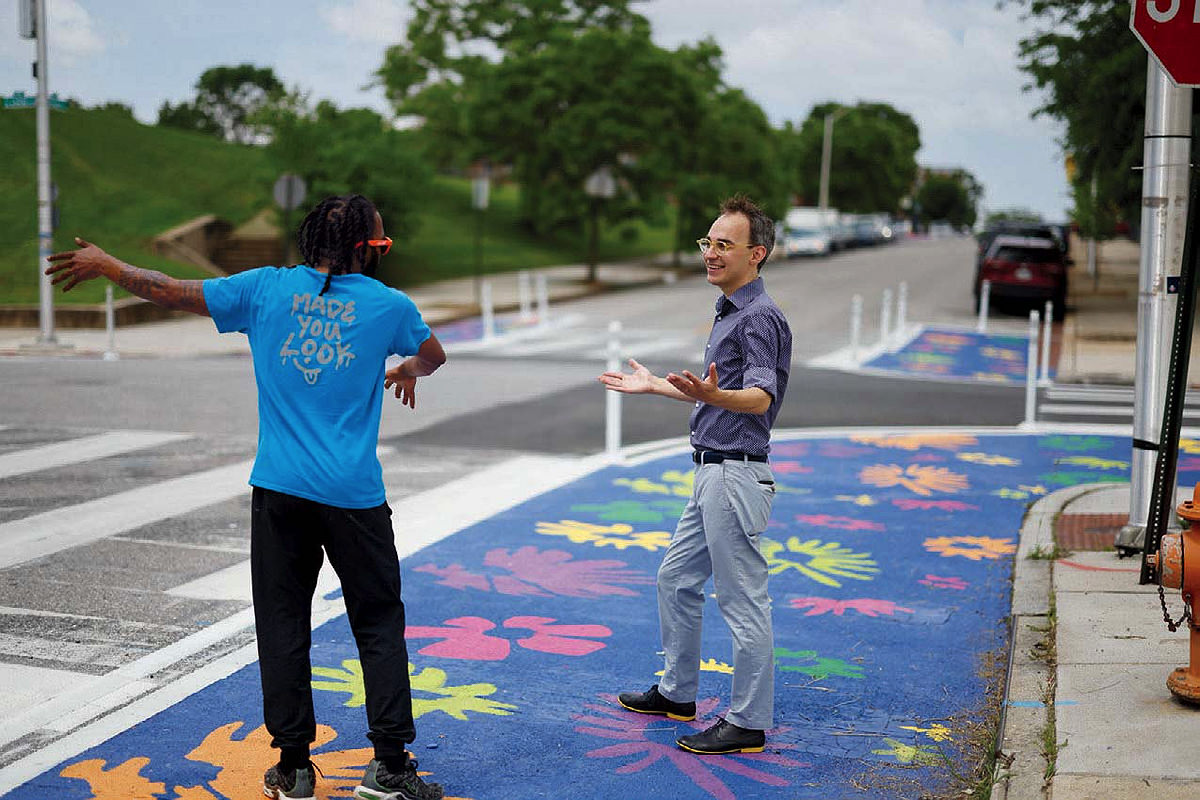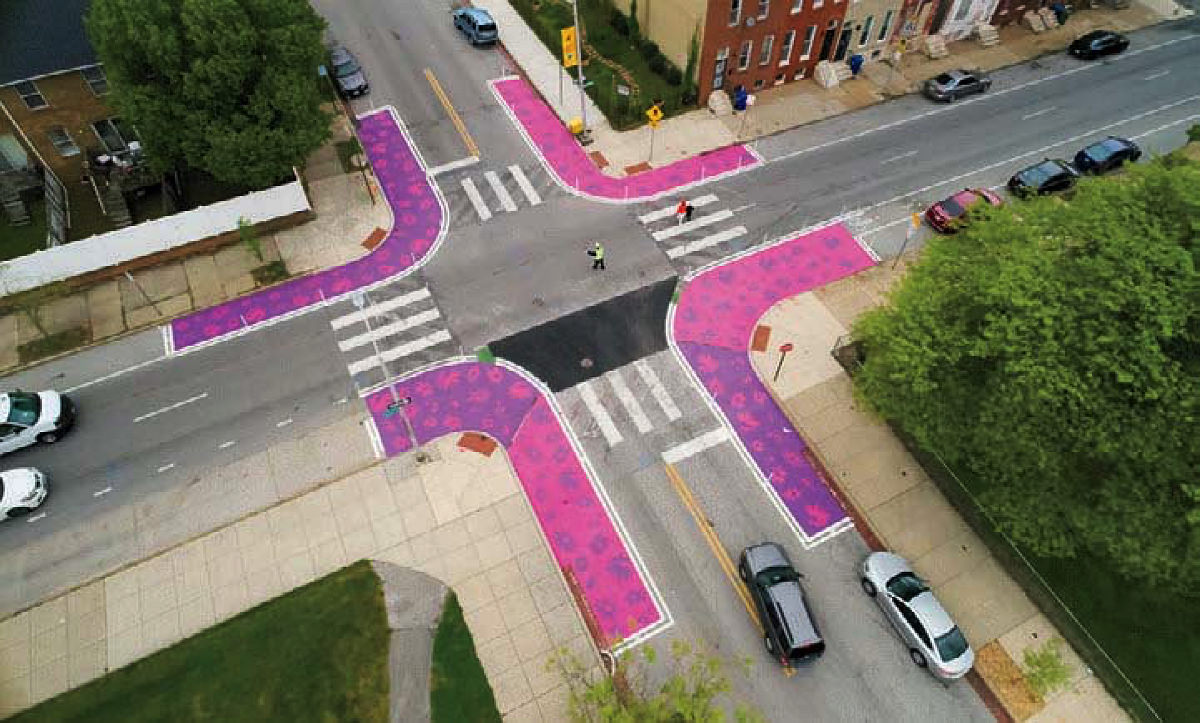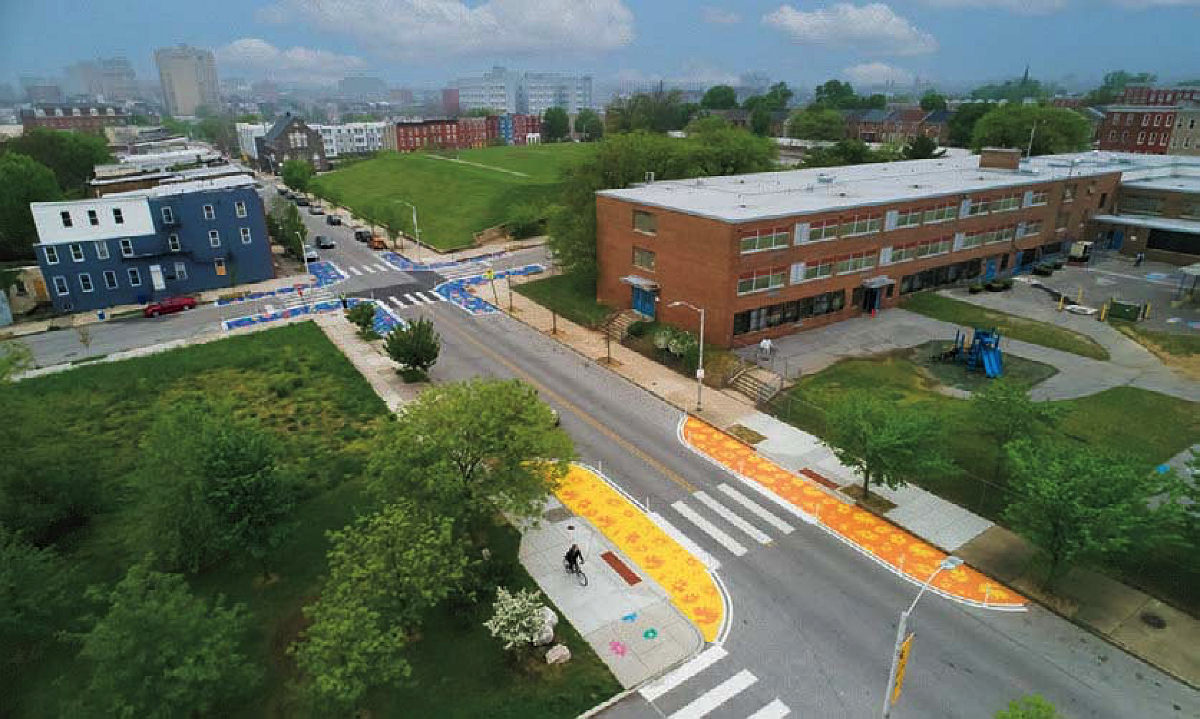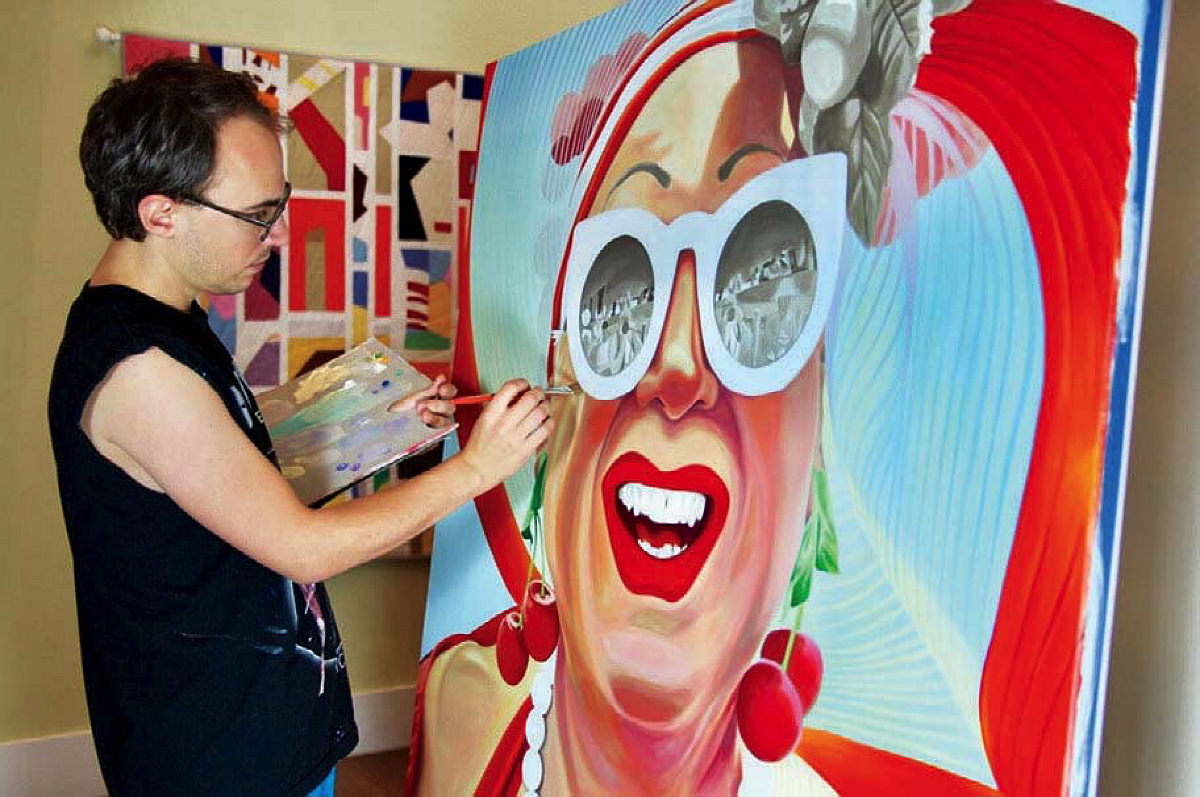At Baltimore’s Johnston Square Elementary School, hundreds of students and staffers pour through the doors twice a day, braving intersections where cars travel up to 80 miles an hour. Nearby, not long ago, a toddler was struck and killed. The crossing guards themselves have had to stand in the way of speeding cars and trucks to get them to slow down. But what else could be done?
The community and city traffic engineers landed on a unique solution: asphalt art. Three dangerous junctions were reconfigured, then painted with swirling flowers and bees in fantastical colors. That artful intervention, completed earlier this year, calmed both traffic and pedestrian nerves and enlivened daily life for everyone passing through. “Asphalt art really gets to the heart of creative ‘placemaking’—taking a swath of gray asphalt or concrete and turning it into a vibrant destination in and of itself,” says David Andersson ’09, of the arts and culture team at Bloomberg Associates (the pro bono consulting arm of Bloomberg Philanthropies), where he manages the Asphalt Art Initiative and guided and funded the Baltimore project.
In Baltimore, designers Quinton Batts and Vilde Ulset worked with Rebuild Johnston Square to pick a pattern and choose a different color scheme for each intersection, Andersson explains, “so that people could say ‘I’ll meet you at the pink one, or the blue one, or the yellow one’—really making each intersection a uniquely lively space.” The project, which involved a hundred volunteers on the the ground during two weekends, brought residents together to tangibly improve their daily lives. “It wasn’t just the added aesthetic element that was immediately apparent when I visited,” he notes, “but also talking to the Johnston Square residents made me understand the sense of pride and ownership they felt every time they crossed these streets.”
Arts and culture have a “ripple-out effect,” he adds. In urban life, that extends to the economy, education, public health, safety, “and just general quality of life. Culture is at the heart of thriving cities.” As proof, he points to the 2017 study he worked on with the University of Pennsylvania’s Social Impact of the Arts Project. Researchers looked at low-income communities with differing arts assets and found that those with more “had significantly better social wellness indicators across crime rates, educational success, and even obesity rates,” Andersson says. “There are many individual stories of how arts and culture make a vibrant city, but to actually see those numbers play out makes the case even clearer.”



David Andersson and Quinton Batts confer at the Baltimore site; aerial views capture the colorful transformations of the urban streetscapes.
Photographs courtesy of Bloomberg Philanthropies (3)
The early metrics from the Baltimore project are encouraging. No speed-rate comparisons are available, but an analysis found that the percentage of cars yielding to pedestrians rose 41 percent after the roadway murals were installed. This echoes data from a broader safety study Andersson worked on with Sam Schwartz Consulting, which showed that among 22 asphalt art projects across the country, there was a 50 percent decrease in rate of car crashes involving pedestrians or cyclists, and a 27 percent rise in drivers yielding to pedestrians with the right of way. And as far as infrastructure projects go, aside from any hardscape construction costs, asphalt art can be relatively inexpensive; typically requiring gallons of paint, volunteer workers, and the cost of artists’ fees. The Asphalt Art Initiative has so far funded 42 projects in the United States and recently launched a pilot program in Europe. The endeavor, says Andersson, “is about recognizing that there’s an opportunity for communities to shape their public realm, and to have an impact on the bland, banal infrastructure that is everywhere in cities by making it a highlight that people can get excited about, but which can also make real improvements” in safety and quality of life.
Perhaps more than most alumni, Andersson’s undergraduate passions—his social studies concentration and four years of ensemble productions with the Hasty Pudding Theatricals (the last as president)—directly fed his professional work. He discovered social theory during a sophomore social studies seminar taught by Titcomb professor of African and African American studies and of philosophy Tommie Shelby. “It was a totally different way of thinking for me,” he recalls. “I’d never really thought about why society is the way it is.” The course covered fundamental classics on the development of modern societies—by Immanuel Kant, Adam Smith, Max Weber, among others—and opened Andersson’s mind to how individuals exist within a social construct.
This line of thinking, combined with his own thirst for the intensity of urban life (he grew up in New York City) and his theatrical interests, led him to explore the intersection of aesthetics and cities. “Whether a street or a park or a library or a train station, spaces that are open to the public are filled with so much potential because they can be inhabited by everybody—they are the common meeting grounds on which society shapes itself,” Andersson says. “And when you bring artists to the table, you create endless possibilities for reimagining what these spaces—and society—can be.” Especially intrigued by the early flash mobs, he wrote his senior thesis on the topic: “‘This Train is Not a Playground’: Improv Everywhere and Urban Public Pranks” (for which he won a Hoopes Prize, under the guidance of his adviser, lecturer Kiku Adatto). “These pranks were silly, fun activities, but they did ultimately change the way someone experienced the public space—the place where they lived and worked every day,” he adds. “That’s really powerful.”
After graduation, Andersson and his then-boyfriend, now husband, Andrew Fine ’09, worked as research managers for Let’s Go, then used their earnings and his Hoopes prize money to travel around the world for nine months. Back stateside, they moved to Manhattan. Andersson joined a landscape architecture and urban planning firm before working for the city from 2012 to 2016, ultimately becoming director of special projects for the NYC Department of Cultural Affairs (spanning both the Michael R. Bloomberg, M.B.A. ’66, LL.D. ’14, and Bill de Blasio administrations).
By then he’d delved into his own art: large-scale painted portraits in blazing colors and sewn creatures. “I love the feeling of taking a blank canvas and slowly transforming it into a person’s face—having that glint in there that really shows they’re alive,” he says. And his stuffed creations range from the traditional to “quirky, bizarre, little whatevers.” He joined Bloomberg Associates in 2018 and now brings much of what had succeeded in New York City—developing more walking and biking infrastructure, transforming public parks and playgrounds, and investing in public art and programs—to other municipalities. His core job is advising administrators about starting or strengthening arts-related infrastructure, like grant and exhibition programs, public art installations, and studio and performance spaces, along with developing education centers and creative-class hubs.
What excites Andersson is the creative ensemble production. “Artists and government workers often don’t speak the same language, and so trying to come up with an understanding of arts as a public service that satisfies both parties can be a mind puzzle,” he says. “Cities need arts and culture in order to be desirable places to live, and artists need cities for inspiration and energy and resources. It’s a bit of a wacky match, but given my experience as both an artist and a bureaucrat, I’m happy to be the one to play matchmaker.”

Andersson at work on one of his own large-scale paintings that highlight human vitality.
Photograph courtesy of David Andersson
Andersson also specializes in guiding governance processes and analyzing arts data. Working for the city’s arts agency, he unwittingly became the “data guy.” “I’m really not a data guy,” he laughs, “but I was pretty good at creating spreadsheets.” Cities, he has since discovered, collect piles of data through their arts grant programs, but then they don’t often do much with the information beyond addressing compliance requirements. He now helps arts agencies mine and analyze their data and use their findings to better serve grantees, promote equity in service delivery, and demonstrate the impact of arts and culture across a range of civic priorities. (Bloomberg Associates’ recently produced guide Arts Data in the Public Sector, which Andersson worked on, helps cities cultivate their own arts and culture “data people.”)
In this age of cultural change, like that forged by Black Lives Matter, Andersson’s work can also play a pivotal role in the rebirth of more inclusive, contemporary-minded public spaces. “Art,” he says, “can really foster a psychological shift.”
In Newark, New Jersey, he helped the city establish a grant program for artists and cultural organizations, and has since been instrumental in developing a commissioning process to replace the Christopher Columbus statue removed from a downtown park following calls for racial justice in summer 2020. “There are so many empty pedestals across the country right now,” he adds, “and Newark is one of the first to grapple with what will come next in the space.” The new monument, Shadow of a Face, designed by New Jersey-based architect Nina Cooke John, honors Harriet Tubman and New Jersey’s role in the Underground Railroad. It will be unveiled this fall. Conceived as a gathering space, the work’s circular grounding, Andersson explains, invites people to walk along a wall with text explaining Tubman and the Underground Railroad, and to view a community mosaic, listen to audio histories, or just relax on the built-in benches.
Andersson thrives on just this kind of challenging, multi-stakeholder effort to transform public space. It can reveal how the movement for public art goes way beyond murals, decorative utility-boxes, street sculptures, or even monuments. “Activating a street or a park with community-driven art is a demonstration of neighborhood investment,” he says, recalling one Baltimore resident’s response to the new splashy array of flowers and bees on the street: “The crosswalks make the area look pretty and make people stop and think, ‘Hey, somebody here cares!’”








